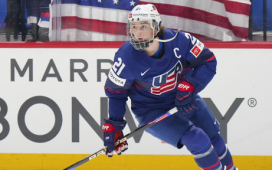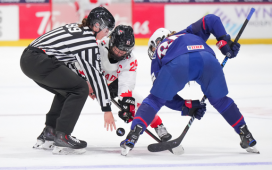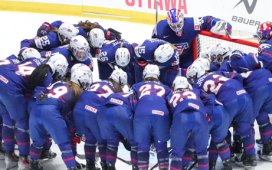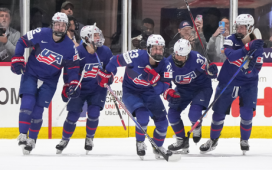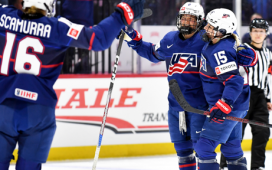“He looks like he’d be able to play the game sitting in a rocking chair.”
“He’s so calm that he almost looks bored out there.”
“He always has the puck, and nobody is able to get it away from him.”
The scout, like so many at the time, was captivated by Ryan Ellis’ game. Those quips accompanied’ Ellis bio in The Hockey News’ 2009 Draft Preview special. We ranked Ellis 17th overall that year, but don’t think we were low on him because the Nashville Predators took him 11th. A ranking of 17th for a defenseman listed at 5-foot-10 and 173 pounds was a massive compliment in 2009, when the game hadn’t kicked its bias against small players yet. It was the equivalent of projecting Ellis in the top 10 today.
Which is to say we, like so many prognosticators at the time, loved Ellis’ potential. He was a magical power-play quarterback, a gold-medallist with Canada at the world juniors as an 18-year-old. By the end of his final major junior season with the OHL’s Windsor Spitfires, he’d won consecutive Memorial Cups as a key member of the Taylor-Hall-led powerhouses. Ellis ripped off an absurd 101 points in 58 games during his final season of major junior. No CHL blueliner has hit the century mark since, and he’s the only one to do it in the past 18 years.
So we always knew the offensive ceiling was tantalizingly high for Ellis. Through the first eight seasons of his NHL career, he hadn’t quite realized it, even though he’d developed into a far better all-around defenseman than expected. Operating on a regular pairing with Roman Josi, Ellis has emerged as one of the better two-way blueliners in hockey, a modernized version of a good defender in the 2019 landscape, where speed and positioning trump brute strength. But it still felt like he was leaving some meat on the bone offensively given his tremendous mobility, point shot and puck-moving acumen. Through seasons 1 to 8, he averaged 36.7 points per 82 games. Ellis had become a crucial member of a Predators team that went to the 2017 Stanley Cup final but, aside from his injury-shortened 2017-18 campaign, never flashed the ceiling of a top-tier offensive defenseman.
But was that Ellis’ fault? Since 2013-14, his first full season as an NHLer, his ranks in points per 60 minutes among defensemen who played 1,000 minutes or more at 5-on-5 are:
2013-14: 23rd out of 201
2014-15: 3rd out of 204
2015-16: 38th out of 198
2016-17: 48th out of 197
2017-18: 2nd out of 212
2018-19: 32nd out of 209
So Ellis’ 5-on-5 production has ranged from very good to elite in every one of his full NHL campaigns to date. Why, then, hasn’t he churned out 50-point seasons in his sleep? Well, Ellis is a right-handed shooter, which means he spent his first several seasons as a Predator stuck behind Mr. Shea Weber and his booming right-handed shot. Then, Weber’s trade to Montreal returned another star right-shot offensive blueliner, Mr. P.K. Subban.
Ellis’ ranks among NHL defensemen (min. 25 games) in power-play minutes per game since his first full season:
2013-14: 84th of 227
2014-15: 56th of 224
2015-16: 58th of 223
2016-17: 49th of 222
2017-18: 46th of 231
2018-19: 47th of 223
Ellis was too good of a puck-mover not to earn power-play time, but he never got bellcow minutes with the extra man. During Ellis’ NHL career, the Predators have consistently deployed too many outstanding defensemen to leave any one of them out on the power play for the full two minutes.
This past off-season, however, the Preds traded Subban to the New Jersey Devils to clear $9 million of salary-cap space, most of which they invested in center Matt Duchene. For the first time in his career, Ellis was indisputably the top right-shot defenseman on his own team. It set him up for a long-awaited breakout season at age 28.
So far this season: Supernova Ellis has seemingly arrived. He’s rattled off a goal and 12 points in his first 10 games. He’s top three in the league in points per 60. Yet he was always a force at even strength, so the explosion in his overall statline must be from increased power-play time, right?
Well, sort of. His rank in power-play usage among NHL blueliners so far this season: 42nd. That’s a career best, as is his 2:30 of power-play time per game. He does have three assists on the power play. But, for now, the Preds are deploying four forwards on their top power-play unit, with Josi the lone blueliner. Ellis remains relegated to No. 2 duty. Is it because he hasn’t been effective on the power play or because he’s played on some weak power-play units? From 2016-17 to 2018-19, among D-men with 100 or more minutes of power-play time, he sat 90th out of 119 in points per 60, yet Nashville as a team was also 26th in power-play efficiency over that stretch, and Ellis wasn’t getting regular runs with the top-unit talent.
So, then, can we trust 2019-20’s early returns as evidence of an Ellis breakout? Since he’s always had the talent to be a premier scorer at his position and he is seeing a bit more time with the extra man, it wouldn’t be remotely surprising to see him set career highs across the board. But he’s unlikely to join the league’s elite blueline scorers until we see more significant changes in his usage. We might see his first 50-point season, but don’t bet on 60-plus.
Advanced stats courtesy of naturalstattrick.com
Want more in-depth features, analysis and an All-Access pass to the latest content? Subscribe to The Hockey News magazine.


